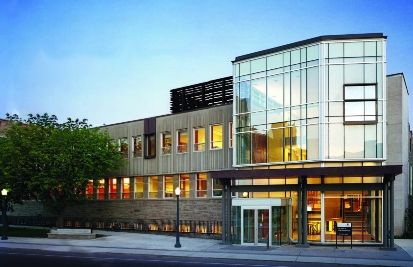
The Indigenous Art Commission, launched by Queen’s Law in September 2017, is in the second phase of a public call for an Indigenous artist to create a permanent artwork for the school’s atrium. Three proposals have been shortlisted by the project committee.
“The Indigenous community at Queen’s Law is excited to have a permanent visual representation of our heritage, culture and presences on campus,” says Ann Deer, Indigenous Recruitment and Support Co-ordinator and project committee member. “This art will reflect our history, present and future in Canada, and the evolution of law.”
The shortlisted artists will publicly present their proposals and will answer questions on March 12, noon–1:00 pm, in the Queen’s Law atrium – where the winning project will be installed this fall. Each artist will present a three-dimensional maquette or digital scale-rendering of his or her proposal, and attendees of the open drop-in will have an opportunity to submit comment cards. Later that day, from 3:30–4:30 pm at an Agnes Etherington Art Centre reception, all those who are interested can meet and chat with members of the project committee and the three shortlisted artists:
- Rebecca Baird, whose proposal is entitled “Kihewataniy” (“eagle feather” in Cree);
- Hannah Claus, whose proposal is entitled “Words That Are Lasting;” and
- Wally Dion, whose proposal is entitled “It will put your mind at ease, that we still remember these words.”
The Indigenous Art Commission is part of the Queen’s Law response to the need to further the cause of Reconciliation by increasing the visibility of Indigenous art and culture and the recognition of Indigenous territory on campus. The Commission also seeks to create a welcoming space for Indigenous people in the Faculty of Law and to help promote awareness around historical/contemporary issues that are relevant to Indigenous people and law.
“Queen’s University is situated on traditional Anishinaabe and Haudenosaunee territory,” says Dean Bill Flanagan. “By honouring this traditional territory, we acknowledge its significance for the Indigenous peoples who lived, and continue to live, upon it. Having a work of art that reflects Indigenous culture and values in the entrance to our school will be one of many ways we honour this traditional territory and embrace Indigenous engagement in all that we do in the Faculty of Law.”
For those unable to attend the presentations on March 12 from noon–1:00 pm, a summary of the three shortlisted proposals and an online survey to submit comments, is available on the Indigenous Art Commission web page.
By Ken Cuthbertson